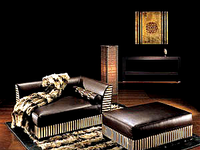In the biologically effective light spectrum
Biologically effective lighting is based on the imitation
of nature through artificial lighting. This is achieved via
both the luminous intensity and the light colours. Out-
doors, the light intensity is several thousand lux – indoors,
1000 – 2000 lux already affects our hormone system.
Large areas with high luminance are important here, so
that the sensitive receptors are reached over a large area
of the retina.
To imitate daylight in terms of colour, the entire light spec-
trum must be covered, and the dynamics and variability of
natural light must be reproduced. The light colour is spe-
cified as colour temperature in Kelvin (K). Ranges below
3300 K are considered warm white, whereas light colours
above 5300 K are called cool white or daylight white. The
cooler the shade of white, the higher the proportion of
blue, short-wave components which have an activating ef-
fect on the organism. In modern luminaires with full-spec-
trum LEDs, specific attention has been paid to achieving
a frequency content of the wavelengths that is close to
natural. Thus, artificial light achieves a biological effect
similar to daylight.
Increased need for light in old age
With increasing age, fewer and fewer light stimuli reach
the retina. From birth, lens opacity and pupil constriction
increase, specifically allowing fewer blue wavelengths
to reach the retina. However, this blue light is needed to
regulate the day-night rhythm of the body and to trigger
the evening release of melatonin.
In nursing homes and care centres a decrease in activity
due to lack of light can be observed. If the body is not
sufficiently activated during the day, sleep deteriorates –
listlessness and even depressive moods are the result. A
research project at the Albert Schweitzer Clinic in Graz
has demonstrated a biological effect. The combined
amount of artificial and daylight was measured over 12
hours. On average ~ 530 lx / h was measured. This provides
a daily dose of 6360 lx / h. Depending on the location with
respect to the window and the patient's age, a daily dose
of 5000 – 10000 lx / h will achieve a biological effect. A
daily synchronisation of the inner clock is essential for an
active life in old age.
Factors for near-natural lighting design
Lighting design oriented towards people is inspired by
lighting conditions in the open air and their positive effects
on health – it is modelled on nature. To this end, artificial
lighting reproduces daylight inside the building and allows
the human organism to maintain its natural rhythm.
The most important factors for a biodynamic lighting
concept are:
• High cylindrical illuminance: > 370 lx
• Take age-specific correction factors into account: with
an MR of 0.75 this means 554 lx of cylindrical illumi-
nance for a 50-year-old, 1153 lx for a 75-year-old, and
1907 lx for a 90-year-old
• Expansiveness: The light should be emitted over large
luminous areas (similar to the daytime sky) if possible
• Light direction: This must be selected such that the
circadian effective light comes from the front and above
• Melanopic efficiency: The non-visual efficiency of the
luminaires should be MR > 0.75
• Dynamic gradients: Slow and, if possible, infinitely va-
riable adjustment of colour temperature and illuminance
correspond to the natural daylight curve
2700 K
warm white
neutral white
6000 K
daylight white
4000 K
5000 K
Activity
Relaxation
xal.com/light-effect-health
63







